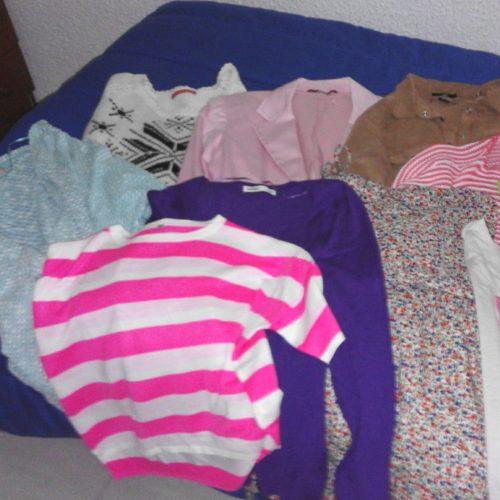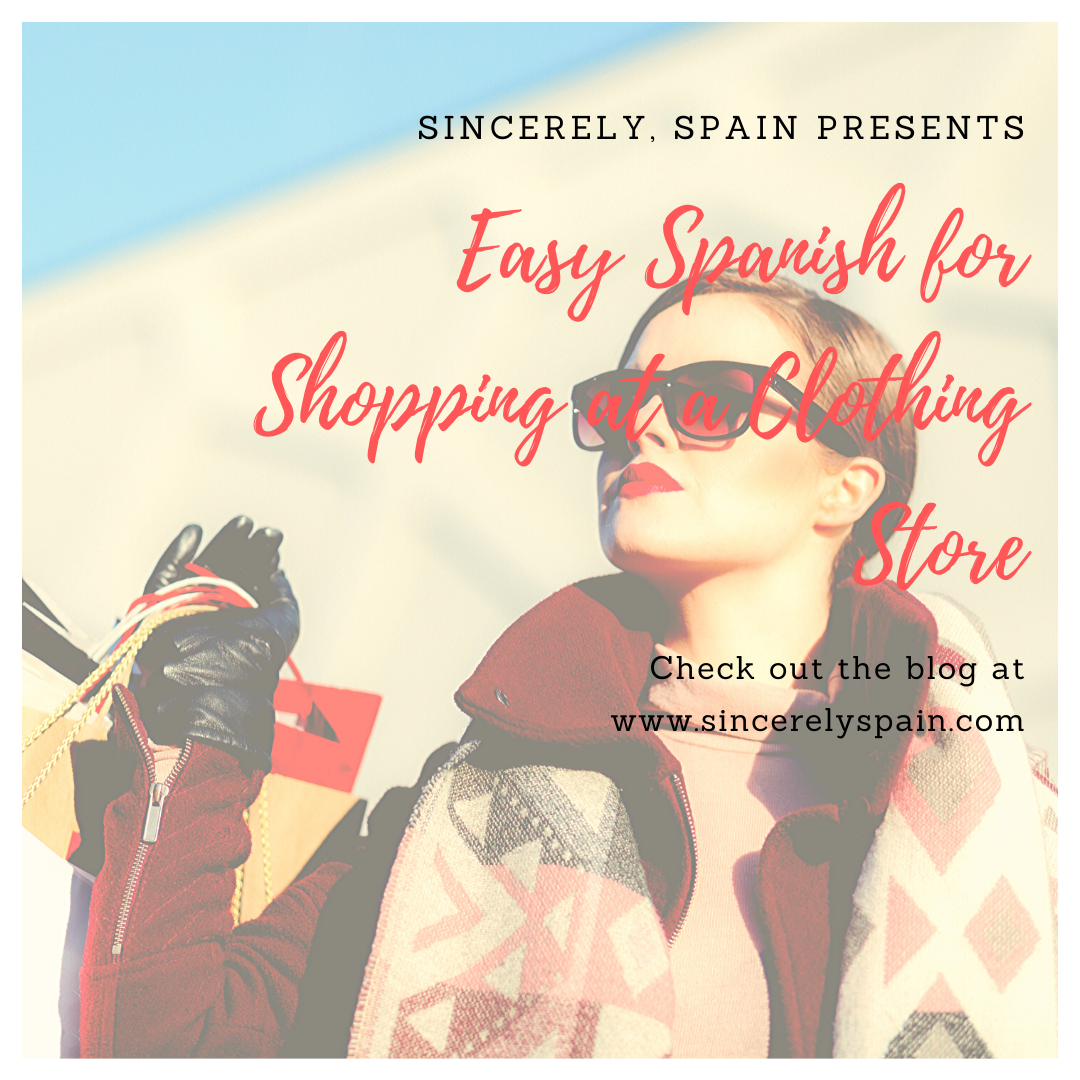
Easy Spanish for Shopping at a Clothing Store

Dear Kara,
Whether you’ll be moving to Spain indefinitely or simply visiting for a week-long vacation, you’re likely to find yourself at a clothing shop at some point. While you could arguably get through this experience with little to no Spanish, we always recommend you prepare yourself by knowing the basics so that you can have a stress-free, successful experience. Besides, it’s nice to feel like you can ask the simple questions you may need to ask as well as respond appropriately to questions asked of you.
Note: This article is just one of our resources in the “Easy Spanish for…” series! If you’re preparing to use your Spanish language skills here in Spain, you may also enjoy our mini guide for Traveling, for restaurants, and for shopping at a supermarket.
Finding your way around the store
Here are a few examples of the common areas you will encounter in a clothing store:
Mujeres: Women’s
Hombres: Men’s
Ninos: Kids’
Zapateria: Shoe section
Bisuteria: Hats / headwear
Probadores: Dressing rooms
Caja / Cajero: Register
Devolucion/es: Returns
Clothing Items
Here is a list of some of the most common clothing items you may want to look for / ask about:
Camisa: Top / shirt
Camiseta: T-shirt
Top: Tube top
Pantalones: Pants (trousers)
Vaqueros: Jeans
Pantalones cortos (shorts): Shorts
Leggings: Leggings
Falda: Skirt
Vestido: Dress
Jersey (sueter): Sweater (jumper)
Sudadero: Sweatshirt
Rebeca (cardigan): Cardigan
Chandal: Track suit
Traje: Suit
Corbata: Tie
Pijamas: Pajamas
Traje de baño: Swimsuit
Bikini: Bikini
Ropa de deporte: Sportswear
Ropa interior: Underwear (unisex)
Bragas: Panties
Calzoncillos: Briefs
Calcetines: Socks
Zapatos: Shoes
Zapatillas: Gym shoes (trainers)
Botas: Boots
Botines: Booties (short boots)
Tacones: Heels
Sandalias: Sandals
Chanclas: Flip flops
Gorro: (Winter) Hat
Gorra: Baseball cap
Bufanda: (Winter) scarf
Pañuelo: (Decorative) scarf
Guantes: Gloves
Abrigo: Coat
Chaqueta: Jacket
Describing clothes
The following words / expressions could be useful for you when describing exactly what you are looking for. Simply keep in mind that adjectives go AFTER the nouns they modify in Spanish so instead of saying “a sleeveless shirt” we would say “una camisa sin mangas.”
De manga larga: Long-sleeve
De manga corta: Short-sleeve
Sin mangas: Sleeveless
Algodón: Cotton
Piel: Leather
Lana: Wool
Vaquero: Jean
Useful Phrases
Of course, it’s always helpful to have some complete phrases up your sleeve in order to practice ahead of time and feel confident if you need to use them. These are a few we use often:
¿Tiene esto en otra talla? Do you have this in another size?
¿Tiene esto en otro color? Do you have this is another color?
Quiero probarlo. I want to try it on.
Es un poco grande. It’s a little big.
Es un poco pequeño. It’s a little small.
No me queda bien. It doesn’t fit me well.
And a few we hear often, with a common response or two:
¿Le puede ayudar en algo? Could I help you with anything?
Si, estoy buscando… Yes, I’m looking for…
No, gracias. Solo estoy echando un vistazo. No thanks. Just looking/browsing.
¿Quieres probarlo? Would you like to try it on?
¿Cuantas prendas tienes? How many items do you have?
¿List@ para comprar?* Ready to purchase?
Puedo atender el próximo cliente. I can help the next customer.
¿(Quieres) una bolsa? (Do you want) a bag?
¿En efectivo o con tarjeta? In cash or by card?
¿Quieres el ticket? / ¿Quieres factura? Do you want a receipt?
A Final Thought
One interesting thing to note about sizing in Spain is that although you can use the Spanish equivalents (such as pequeño, mediano, grande, etc, for “small,” “medium,” “large,” etc), it is actually most common for Spaniards to refer to sizes by their letter…for the size written in English! However, keep in mind that they letters are then pronounced in Spanish so it might sound different to you. For example, if you’re looking for a size extra small you would say “un XS” which is pronounced /un ek-keys es-say/, a small as “un S,” pronounced /un es-say/, a medium as “un M,” pronounced /un em-ay/, a large as “un L,” pronounced /un el-ay/, an extra large as “un XL,” pronounced /un ek-keys el-ay/, and so on.
 Are there any specific doubts you have about Spanish for shopping for clothes? As always, let us know how we can help you and stayed tuned for more information on this topic this week!
Are there any specific doubts you have about Spanish for shopping for clothes? As always, let us know how we can help you and stayed tuned for more information on this topic this week!
Sincerely,
Spain
*In the Spanish speaking world, adjectives often end in ‘a’ when referring to a female and ‘o’ when referring to a male and so in cases in which a gender is not specified, it has been common to insert an @ or x. If you see the “@” symbol in any of our words, that’s what it means!









2 Comments
leslie.emojiai@gmail.com
These men’s suits and tie ideas are giving a clear perspective on customer demands. I love the clothing tips and would love to get one for my fiance.
Sincerely, Spain
Thanks for the comment and glad to hear you’ve enjoyed the clothing tips for shopping in Spain!